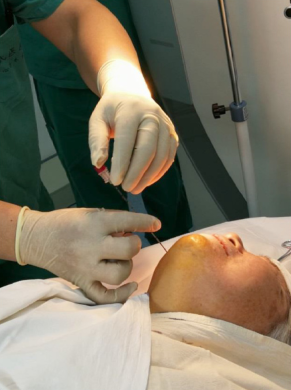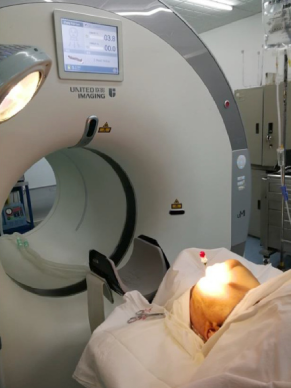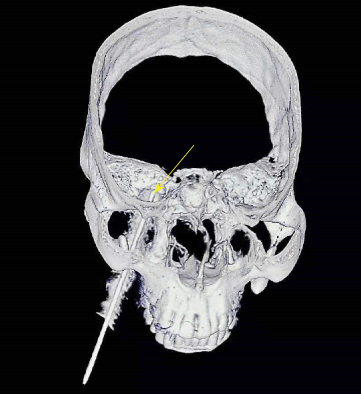Published online May 6, 2019. doi: 10.12998/wjcc.v7.i9.1060
Peer-review started: January 10, 2019
First decision: January 26, 2019
Revised: February 21, 2019
Accepted: March 16, 2019
Article in press: March 16, 2019
Published online: May 6, 2019
Processing time: 117 Days and 2.7 Hours
Trigeminal neuralgia (TN) is a severe type of neuropathic pain which is often inadequately managed using conventional therapies. In this report, we present the first case of TN treated with gasserian ganglion nerve coblation (NC).
A 58-year-old man presented with right facial pain, mostly localized in the right zygomatic zone, alveolar region, and jaws. Similar to acupuncture and shock pain, the pain lasted about five seconds after each attack before resolving unaided. A diagnosis of TN was made, after which treatment with acupuncture therapy and oral carbamazepine was given. However, the pain was not satisfactorily controlled. Subsequently, gasserian ganglion NC of the right trigeminal nerve guided by computed tomography (CT) was performed on the patient. Following this procedure, the right zygomatic, alveolar, submandibular, and cheek pain disappeared completely. The right zygomatic and alveolar areas experienced mild numbness (level II). At 1-, 2-, 3-, and 6-mo follow-ups after surgery, the patient was painless and the numbness score was level I.
CT-guided gasserian ganglion (NC) is an effective treatment for TN and is associated with less or no postoperative numbness or hypoesthesia in comparison with current standard-of-care approaches.
Core tip: Pain due to diseases or injuries affecting the trigeminal nerve can be devastating. Conventional drug-based therapies are often ineffective in controlling advanced trigeminal neuralgia (TN). On the other hand, surgical interventions, although showing better success than most drugs, are at times accompanied by numbness and relapsing pain. In this case, we report the treatment of a patient who presented with signs of TN using an innovative technique, computed tomography (CT)-guided nerve coblation (NC). The patient reported neither feeling pain nor numbness when followed for up to a period of six months. CT-NC, therefore, is a minimally invasive technique for the treatment of TN bearing the advantages of inducing little trauma and being effective in alleviating pain without causing postoperative numbness.
- Citation: Yang XH, Li Y, Yang LQ, Wu BS, Ni JX. Nerve coblation for treatment of trigeminal neuralgia: A case report. World J Clin Cases 2019; 7(9): 1060-1065
- URL: https://www.wjgnet.com/2307-8960/full/v7/i9/1060.htm
- DOI: https://dx.doi.org/10.12998/wjcc.v7.i9.1060
Trigeminal neuralgia (TN) is characterized by sudden, severe, brief, stabbing, and recurrent pain, with a reported incidence of about 13/100000 persons every year[1]. The etiology of the disease remains unclear and its clinical management, comprising medicinal and surgical approaches, is similarly inadequate. Technological advancements have paved the way for the application of minimally invasive interventional therapy, such as the treatment of TN. Benefits of these moments include little trauma, quick recovery, and adequate pain control.
However, postoperative numbness or hypoesthesia is the most common complication after treatment using the invasive techniques[2]. We therefore explored the gasserian ganglion nerve coblation (NC) technique to treat a patient with TN in the Department of Pain Medicine, Xuanwu Hospital, Beijing, China.
A 58-year-old man presented with chronic right facial pain and was followed at our hospital for about eight years. The pain was described as paroxysmal puncture with no obvious cause, mostly located in the right zygomatic zone, upper alveolar region, and jaws. Moreover, the pain, with a VAS score of 7-8 points, continued for about five seconds during each attack and resolved without intervention.
Identifiable triggers for the pain included activities such as eating, talking, brushing of the teeth, washing the face, and touching. Initially, the patient was started on acupuncture therapy together with oral carbamazepine (100 mg, once per day but still complained of right facial pain.
On further examination, we found that there was a trigger point on the right side of the zygomatic zone. However, muscles involved in mastication and movement of the mouth were normal and their functions were not limited.
Furthermore, examination of the skull base using magnetic resonance angiography (MRA) returned normal results.
The treatment presented in this Case Report was undertaken after obtaining the relevant ethical approval by the institutional review board of Xuanwu Hospital. Additionally, we obtained a signed informed consent form from the patient towards publishing this case report.
On November 23, 2017, the patient received gasserian ganglion NC of the right trigeminal nerve guided by computed tomography (CT) at the positron-emission tomography-CT room of Xuanwu Hospital. As there was no standardized technique procedure, we adopted the method of CT-guided percutaneous radiofrequency thermocoagulation[1].
Prior to the procedure, the CT examination room was disinfected and the patient placed in a supine position with his head overhanging on the CT scanner bed. Vital signs were monitored during the entire procedure. First, access to the gasserian ganglion was explored following the Hartel’s anterior route. The target was confirmed by CT scan to find the foramen ovale and mark the best puncture path (Figures 1 and 2). The route from the puncture point to the target was measured as a predetermined distance to ensure that skeletal obstacles were circumvented. An intravenous drip of 5 μg of sufentanil was conducted to relieve pain before puncture. After sterilization, the insertion point was anesthetized with 2 mL of 1% lidocaine. Second, a 150 mm 18G puncture needle was inserted. The angle and depth of insertion of the needle to the foramen ovale followed the best puncture approach. While piercing the needle into the foramen ovale, a repeat CT scan was done to ascertain the position of the needle tip (Figures 3 and 4). Third, the needle core was pulled out, and the coblation wand was inserted into the introducer needle and extended approximately 5 mm beyond the introducer needle. Stimuplex HNS 11 Nerve Stimulator (B. Braun Co. Ltd, Melsungen, Germany) was then connected. Electrical stimulation was induced while observing the patient’s response to the stimulation. This guided the adjustment of the positioning of the wand until the target was accessed. Fourth, intravenous anesthesia comprising propofol (1–2 mg/kg) supplemented with facemask oxygen was administered after certifying the proper location. No tracheal intubation was performed. The coblation wand was changed to connect with a low temperature plasma multi-function operating system SM-D380C (GaoTon Co. Ltd, Xi’an, China). Fifth, the target nerve was ablated by the coblation wand using the following settings: ablation intensity at mode 2 and operation temperature at 40 to 50 °C. Ablation cycle lasted approximately 30 s. Thereafter, the coblation wand was retracted to 3 mm. Finally, the wand and puncture needle were pulled out. After the procedure, dressing was applied to the patient who, after regaining consciousness, was returned to the ward and instructed to rest for 24 h.
The patient was followed for 3 d after the surgery. On examination, the right zygomatic, alveolar, submandibular, and cheek pain had disappeared completely with a VAS score of 0. The right zygomatic and alveolar regions manifested some mild numbness (level II). During follow-ups at 1, 2, 3, and 6 mo after surgery, the VAS score for pain was 0 and the numbness score was level I. The patient reported no other adverse effects during the follow-up examinations.
Early TN treatment is dominated by the use of drugs with carbamazepine as the drug of choice achieved pain control in 70% to 98% of patients[3,4]. With progression of the disease, carbamazepine, even at high doses, becomes ineffective in alleviating pain. In fact, higher doses of the drug can cause side effects, such as dizziness, drowsiness, fatigue, nausea, rashes, vomiting, occasional granulocytopenia, reversible thrombocytopenia, and even aplastic anemia and toxic hepatitis. Many patients, therefore, cannot tolerate high dose medication[5,6].
Surgical intervention becomes an alternative to treat TN when drug therapy fails. Presently, surgical methods are mainly divided into minimally invasive intervention and open surgery. The former includes the radiofrequency thermal coagulation of the trigeminal nerve[7], glycerol neurolysis[8], and percutaneous ganglion balloon compression[9]. On the other hand, open surgery includes trigeminal nerve root microvascular decompression[10], posterior root amputation of trigeminal nerve, and spinal cord amputation. A notable disadvantage of open surgery is that it requires craniotomy under general anesthesia, which may cause significant trauma. Greater risks and, in some cases, higher mortality rate have been associated with open surgery[10,11]. Minimally invasive interventional therapy has therefore become a preferred approach in the treatment of TN since it elicits little trauma, allows for quick recovery, and achieves effective relief of pain .
The case reported here was characterized by typical symptoms leading to a clear diagnosis of TN. The latest NC technology guided by CT was employed. The patient did not report feeling any pain three days after the surgery; a VAS score of 0 was recorded. The same results were observed at 1, 2, 3, and 6 mo after the surgery. From the foregoing observation, the pain-relieving effect of CT-guided NC is significantly distinct, and consistent with that reported for radiofrequency thermal coagulation in treating TN[12]. We are conscious, however, that there is need to observe the long-term effects of this procedure on pain relief and numbness. From a mechanistic point of view, NC does not rely on thermal effect as does radiofrequency thermal coagulation[13,14]. However, with 100-500 kHz and special bipolar radiofrequency electric field segment, the high-frequency oscillating tip locally generates a low-temperature plasma layer. The activated ionic layer can break down the molecular bonds (layer thick 1 mm[15]), cut or ablate the nerve tissue, cause it to decompose and vaporize and drain out of the body from the puncture channel, block the pain signal transduction, and do not produce numbness at the same time. The patient had mild numbness 3 d after surgery, which was scored as level II. At 1, 2, 3, and 6 mo after surgery, numbness disappeared completely and was scored as level I. Postoperative numbness scores were significantly lower than those for the other case reported[2]. Based on the techniques, it may be that the fine fibers (Aδ and C fibers), which transmit temperature sensation and pain, are damaged when ablating nerve tissue. However, there is little damage to the crude fibers (Aα and Aβ fibers) that transmit the sense of touch. Therefore, the incidence of postoperative numbness is low.
As an emerging technology, NC for the treatment of TN has not been extensively explored globally. This is a very promising minimally invasive interventional technique that holds multiple benefits to the patient not least because of effective pain control. A larger patient sample and longer follow-up period are warranted to ascertain the effectiveness of NC in the management of TN.
We conclude that CT-guided gasserian ganglion NC is a promising, effective treatment for TN and associated with minimal or non-postoperative numbness or hypoesthesia.
Author contributions: Yang XH designed and wrote the report; Ni JX reviewed the manuscript for its intellectual content and revised the entire work; Li Y, Yang LQ, and Wu BS performed the analysis and evaluations; Yang XH and Ni JX reviewed the manuscript for its intellectual content; all authors have read and approved the final manuscript.
Manuscript source: Unsolicited manuscript
Specialty type: Medicine, research and experimental
Country of origin: China
Peer-review report classification
Grade A (Excellent): 0
Grade B (Very good): 0
Grade C (Good): C, C, C
Grade D (Fair): 0
Grade E (Poor): 0
P-Reviewer: Fekaj E, Solfrizzi V, Zhang GL S-Editor: Ji FF L-Editor: Wang TQ E-Editor: Wu YXJ
| 1. | Koopman JS, Dieleman JP, Huygen FJ, de Mos M, Martin CG, Sturkenboom MC. Incidence of facial pain in the general population. Pain. 2009;147:122-127. [RCA] [PubMed] [DOI] [Full Text] [Cited by in Crossref: 300] [Cited by in RCA: 305] [Article Influence: 19.1] [Reference Citation Analysis (0)] |
| 2. | Bozkurt M, Al-Beyati ES, Ozdemir M, Kahilogullari G, Elhan AH, Savas A, Kanpolat Y. Management of bilateral trigeminal neuralgia with trigeminal radiofrequency rhizotomy: a treatment strategy for the life-long disease. Acta Neurochir (Wien). 2012;154:785-791; discussion 791-792. [RCA] [PubMed] [DOI] [Full Text] [Cited by in Crossref: 23] [Cited by in RCA: 31] [Article Influence: 2.4] [Reference Citation Analysis (0)] |
| 3. | Nurmikko TJ, Eldridge PR. Trigeminal neuralgia--pathophysiology, diagnosis and current treatment. Br J Anaesth. 2001;87:117-132. [RCA] [PubMed] [DOI] [Full Text] [Cited by in Crossref: 268] [Cited by in RCA: 249] [Article Influence: 10.4] [Reference Citation Analysis (0)] |
| 4. | Joffroy A, Levivier M, Massager N. Trigeminal neuralgia. Pathophysiology and treatment. Acta Neurol Belg. 2001;101:20-25. [RCA] [PubMed] [DOI] [Full Text] [Cited by in Crossref: 29] [Cited by in RCA: 27] [Article Influence: 1.1] [Reference Citation Analysis (0)] |
| 5. | Canavero S, Bonicalzi V. Drug therapy of trigeminal neuralgia. Expert Rev Neurother. 2006;6:429-440. [RCA] [PubMed] [DOI] [Full Text] [Cited by in Crossref: 29] [Cited by in RCA: 34] [Article Influence: 1.8] [Reference Citation Analysis (0)] |
| 6. | Jorns TP, Zakrzewska JM. Evidence-based approach to the medical management of trigeminal neuralgia. Br J Neurosurg. 2007;21:253-261. [RCA] [PubMed] [DOI] [Full Text] [Cited by in Crossref: 81] [Cited by in RCA: 64] [Article Influence: 3.6] [Reference Citation Analysis (0)] |
| 7. | Sweet WH, Wepsic JG. Controlled thermocoagulation of trigeminal ganglion and rootlets for differential destruction of pain fibers. 1. Trigeminal neuralgia. J Neurosurg. 1974;40:143-156. [RCA] [PubMed] [DOI] [Full Text] [Cited by in Crossref: 467] [Cited by in RCA: 385] [Article Influence: 7.5] [Reference Citation Analysis (0)] |
| 8. | Håkanson S. Trigeminal neuralgia treated by the injection of glycerol into the trigeminal cistern. Neurosurgery. 1981;9:638-646. [RCA] [PubMed] [DOI] [Full Text] [Cited by in Crossref: 2] [Cited by in RCA: 2] [Article Influence: 0.0] [Reference Citation Analysis (0)] |
| 9. | Mullan S, Lichtor T. Percutaneous microcompression of the trigeminal ganglion for trigeminal neuralgia. J Neurosurg. 1983;59:1007-1012. [RCA] [PubMed] [DOI] [Full Text] [Cited by in Crossref: 293] [Cited by in RCA: 277] [Article Influence: 6.6] [Reference Citation Analysis (0)] |
| 10. | Obermann M. Treatment options in trigeminal neuralgia. Ther Adv Neurol Disord. 2010;3:107-115. [RCA] [PubMed] [DOI] [Full Text] [Cited by in Crossref: 95] [Cited by in RCA: 126] [Article Influence: 9.0] [Reference Citation Analysis (0)] |
| 11. | Emril DR, Ho KY. Treatment of trigeminal neuralgia: role of radiofrequency ablation. J Pain Res. 2010;3:249-254. [RCA] [PubMed] [DOI] [Full Text] [Full Text (PDF)] [Cited by in Crossref: 11] [Cited by in RCA: 26] [Article Influence: 1.7] [Reference Citation Analysis (0)] |
| 12. | Tang YZ, Yang LQ, Yue JN, Wang XP, He LL, Ni JX. The optimal radiofrequency temperature in radiofrequency thermocoagulation for idiopathic trigeminal neuralgia: A cohort study. Medicine (Baltimore). 2016;95:e4103. [RCA] [PubMed] [DOI] [Full Text] [Full Text (PDF)] [Cited by in Crossref: 18] [Cited by in RCA: 20] [Article Influence: 2.2] [Reference Citation Analysis (0)] |
| 13. | Stalder KR, Woloszko J, Brown IG, Smith CD. Repetitive plasma discharges in saline solutions. Appl Phys Lett. 2001;79:4503-4505. [DOI] [Full Text] |
| 14. | Woloszko J, Stalder KR, Brown IG. Plasma characteristics of repetitively-pulsed electrical discharges in saline solutions used for surgical procedures. IEEE Trans Plasma Sci. 2002;30:1376-1378. [DOI] [Full Text] |
| 15. | Azzazi A, Elhawary Y. Cervical Nucleoplasty Using Coblation Technology; Clinical Outcome. Neurosurg Quart. 2010;20:146-150. [RCA] [DOI] [Full Text] [Cited by in Crossref: 3] [Cited by in RCA: 3] [Article Influence: 0.2] [Reference Citation Analysis (0)] |












